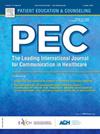Evaluation of a real-world implemented web-based patient education tool for dyspeptic patients: a longitudinal survey study
IF 2.9
2区 医学
Q2 PUBLIC, ENVIRONMENTAL & OCCUPATIONAL HEALTH
引用次数: 0
Abstract
Objective
To explore if a real-world web-based patient education tool has the potential to support self-management and informed decision making in patients with functional dyspepsia.
Methods
The study was performed in the Netherlands between July 2022 and October 2023. It consisted of two web-based questionnaires: the first was filled out directly after participants had finished the tool and the second three months thereafter. The validated PAGI-SYM (Patient Assessment of Gastrointestinal Disorders Symptom Severity Index) was translated to Dutch using the forward-backward method.
Results
Ninety participants were included. Sixty percent of the participants felt (partly) reassured after finishing the tool and a minority changed their intentions of medical care seeking. The recommendations most frequently provided by the tool were dietary changes (83 %), reducing stress or anxiety (70 %) and increasing physical activity (62 %). For each advised lifestyle change, 50 %-77 % of participants stated they were (extremely) likely to try it. The self-reported success rate after three months varied from 38 % to 100 % (n = 59).
Conclusion
Informing patients via the web-based patient education tool has the potential to reassure patients, and support lifestyle changes and informed decision-making regarding medical care seeking.
Practice Implications
The education tool is publicly available, allowing many patients to benefit. Moreover, it is inexpensive and requires minimal maintenance. Therefore, implementing patient education in a real-world setting should be encouraged. Moreover, the translated PAGI-SYM can be used to assess the symptom severity of upper gastrointestinal disorders in Dutch-speaking populations.
对消化不良患者现实世界实施的基于网络的患者教育工具的评估:一项纵向调查研究
目的探讨现实世界中基于网络的患者教育工具是否有潜力支持功能性消化不良患者的自我管理和知情决策。研究于2022年7月至2023年10月在荷兰进行。它包括两个基于网络的调查问卷:第一个是在参与者完成工具后直接填写的,第二个是在三个月后填写的。经验证的PAGI-SYM(胃肠疾病症状严重程度指数患者评估)使用正向-反向方法翻译成荷兰语。结果共纳入90例受试者。60%的参与者在完成工具后感到(部分)放心,少数人改变了他们寻求医疗保健的意图。该工具最常提供的建议是饮食改变(83% %)、减少压力或焦虑(70% %)和增加身体活动(62% %)。对于每一个建议的生活方式改变,50% %- 77% %的参与者表示他们(非常)可能会尝试。三个月后自我报告的成功率从38 %到100 %不等(n = 59)。结论通过基于网络的患者教育工具告知患者有可能使患者放心,并支持生活方式的改变和求医的知情决策。实践意义教育工具是公开的,使许多患者受益。此外,它价格低廉,需要最少的维护。因此,应该鼓励在现实环境中实施患者教育。此外,翻译后的PAGI-SYM可用于评估荷兰语人群上消化道疾病的症状严重程度。
本文章由计算机程序翻译,如有差异,请以英文原文为准。
求助全文
约1分钟内获得全文
求助全文
来源期刊

Patient Education and Counseling
医学-公共卫生、环境卫生与职业卫生
CiteScore
5.60
自引率
11.40%
发文量
384
审稿时长
46 days
期刊介绍:
Patient Education and Counseling is an interdisciplinary, international journal for patient education and health promotion researchers, managers and clinicians. The journal seeks to explore and elucidate the educational, counseling and communication models in health care. Its aim is to provide a forum for fundamental as well as applied research, and to promote the study of organizational issues involved with the delivery of patient education, counseling, health promotion services and training models in improving communication between providers and patients.
 求助内容:
求助内容: 应助结果提醒方式:
应助结果提醒方式:


